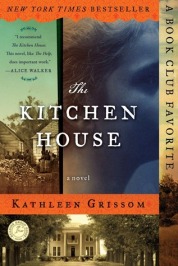All of my life I have hated violence, so much so that I refused to read books or to see movies with violence in them. Opening myself up to read about the atrocities done to slaves was extremely difficult, but I knew that to understand, I had no choice. – Kathleen Grissom
 My Quickie Summary: In late 18th century Virginia, Lavinia, an immigrant girl, serves as an indentured servant alongside a cast of slaves. The usual plantation horrors ensue, even once Lavinia ages and gains the potential power to change things.
My Quickie Summary: In late 18th century Virginia, Lavinia, an immigrant girl, serves as an indentured servant alongside a cast of slaves. The usual plantation horrors ensue, even once Lavinia ages and gains the potential power to change things.
Their Summary: When a white servant girl violates the order of plantation society, she unleashes a tragedy that exposes the worst and best in the people she has come to call her family. Orphaned while onboard ship from Ireland, seven-year-old Lavinia arrives on the steps of a tobacco plantation where she is to live and work with the slaves of the kitchen house. Under the care of Belle, the master’s illegitimate daughter, Lavinia becomes deeply bonded to her adopted family, though she is set apart from them by her white skin. Eventually, Lavinia is accepted into the world of the big house, where the master is absent and the mistress battles opium addiction. Lavinia finds herself perilously straddling two very different worlds. When she is forced to make a choice, loyalties are brought into question, dangerous truths are laid bare, and lives are put at risk.
Thoughts on the Book: It’s always that first 150 pages that you have to climb over before you can really get into a book. The Kitchen House is no different. In the opening chapters, I felt like I wasn’t able to get a full view of the plantation world, nor did I expect to with a 7-year old narrator. But luckily, or so you’d think, this novel had two narrators. Lavinia, the white immigrant girl, and Belle, the older mulatto girl who works in the kitchen house. Together, with Mama Mae, Papa, the twins and a list of others, these characters form a family bond. If you know anything about slave life, you can imagine the events that occur in this book: the overseer and master rape the slave women, a few slaves are killed, a few slaves are unjustly abused, the white mistress has no clue what’s going on, the white children don’t know they’re related to the mulatto slaves even though they look alike, slaves are overworked–etc., etc. I think what makes Kathleen Grissom’s novel different is that she places this white character in the middle of this world of slaves, Lavinia thinks she’s one of them (i.e., a slave), and they accept her and each other as family. Being white, however, presents Lavinia with opportunities her slave family will never have. She’s able to go into the white world, receive an education, and be accepted without question. Because of this, Lavinia believes that she can in turn help the poor black slaves she left behind. Although we already know the plantation horrors of Grissom’s Kitchen House, I don’t believe this makes her novel predictable or any less interesting. We want these characters–minor and major–to triumph, but again, history tells us it’s not likely. The novel moves at a fast pace, presents a worthy story, and features excellent writing on the part of Grissom. A fast and recommended read.
Excerpt: As cold weather approached, our responsibilities grew. The girls were taken up to the big house to learn from Mama, while I was kept down with Belle. When Fanny balked at the housework, Mama sat her down in the kitchen house and, within earshot of Beattie and me, lectured her daughter. “What you thinkin’, Fanny? You forgettin’ that you a slave? You don’t know by now, any time the cap’n want, he can sell you? Anytime Miss Martha say she want you gone, you gone.”
“I’d just say no, I’m stayin’,” Fanny sassed.
Mama’s voice shook. “You listen girl. I’m gonna tell you what happens when you say no to a white man. I watch my own daddy get shot when he saddle up and ride out on a mule to get help for my own sick mama. She havin’ a baby, cryin’ out for help. I standin’ right there when that masta say to my daddy to get down from that mule. When my daddy say, ‘No, I’s going for help,’ that old masta shoot him in the back. That night all I know to do is keep the flies away when I watch my mama die. When that old masta sell me, he say I’m good for nothin’ but the fields. And that’s where I grow up, workin’ hard, right ‘longside Ida, until old Mrs. Pyke call me up to the big house to feed Belle. It don’t take long for me to see what I go to do to stay up there. I work for Mrs. Pyke like I don’t know what tired mean. Nothin’ that I won’t do. ‘Yes, Mrs. Pyek, you right, Mrs. Pyke,’ that all I say. You girls watch me close. I act like I don’t have no mind of my own, except how to make everybody in the big house happy. That because I mean to stay up there, and I tryin’ hard to keep you girls with me . . .
 Kathleen Girssom on drafting The Kitchen House: I didn’t set out to write this story. My husband and I were renovating an old tavern in rural Virginia when we were shown an old map of the region. There we located our house, but also on that map we saw a notation that read “Negro Hill.” There was something about that notation that grabbed me and would not let go. I asked local historians about its meaning, but there was no collective answer. They did agree, though, that it likely represented a tragedy. Then one morning, while sitting to do my daily journaling, in my mind’s eye a movie began to play out and I began to write what I saw. A terrified white woman was racing up a hill. At the top, to her horror, she found a black woman hanging from a tree. I was appalled at what I had written and I wanted no part of it. But day after day, the story kept coming. It was painful and horrifying, yet inspiring and tender. The interesting thing is that the material itself did not feel foreign. As each character presented himself/herself I knew them as completely as I know myself. (Read more . . .)
Kathleen Girssom on drafting The Kitchen House: I didn’t set out to write this story. My husband and I were renovating an old tavern in rural Virginia when we were shown an old map of the region. There we located our house, but also on that map we saw a notation that read “Negro Hill.” There was something about that notation that grabbed me and would not let go. I asked local historians about its meaning, but there was no collective answer. They did agree, though, that it likely represented a tragedy. Then one morning, while sitting to do my daily journaling, in my mind’s eye a movie began to play out and I began to write what I saw. A terrified white woman was racing up a hill. At the top, to her horror, she found a black woman hanging from a tree. I was appalled at what I had written and I wanted no part of it. But day after day, the story kept coming. It was painful and horrifying, yet inspiring and tender. The interesting thing is that the material itself did not feel foreign. As each character presented himself/herself I knew them as completely as I know myself. (Read more . . .)
Girssom’s book research for the novel:
On to the next one. Happy reading, y’all.


This book looks interesting! I’ll definitely add it to my TBR. Where did you learn about this one?
LikeLike
I don’t know where I learned about this book. Probably clicking around on Goodreads or Amazon’s recommended lists.
LikeLike
Thanks! I went on Goodreads and realized that I had already checked it as TBR. Now doesn’t that tell you how long my TBR list is. LOL!
LikeLike
I do think this is a novel approach. Very interesting. Great review.
LikeLike
Thank you!
LikeLike